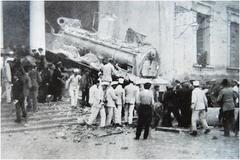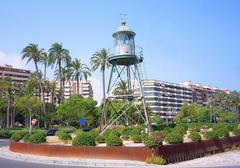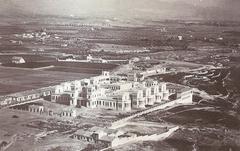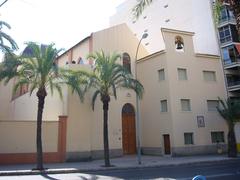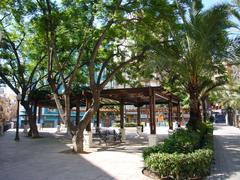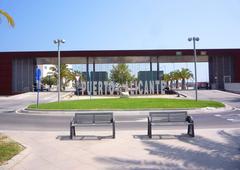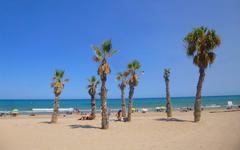Plaza De América Alicante: Visiting Hours, Tickets, and In-Depth Guide to Alicante’s Historical Sites
Date: 14/06/2025
Introduction
Plaza De América in Alicante, Spain, stands as a contemporary symbol of urban revitalization, innovative social housing, and inclusive community life. Rather than a conventional historic plaza, it represents a new chapter in city development: a place where thoughtful architecture, intergenerational living, and public amenities converge. The centerpiece of Plaza De América is its pioneering intergenerational housing project, which uniquely integrates seniors and young adults within a shared residential and community environment. The result is not just a living space, but a vibrant hub of social cohesion and urban vitality.
Located at the intersection of historic neighborhoods like Campoamor and close to key cultural venues such as the Gabriel Miró Municipal Library, Plaza De América is deeply woven into Alicante’s urban fabric. Visitors can enjoy open public spaces, participate in community events, and explore the plaza’s innovative facilities—all with an emphasis on accessibility and cultural engagement.
This comprehensive guide details the history and architectural vision behind Plaza De América, provides essential visitor information (including hours, accessibility, and transportation), and highlights nearby attractions to enrich your experience. Whether you are interested in social innovation, urban regeneration, or simply in search of a welcoming space in Alicante, Plaza De América offers a unique perspective on the city’s past, present, and future.
For further details on its social housing model and urban significance, see the World Habitat Awards and the official Alicante tourism website.
Contents
- Introduction
- Historical Evolution and Urban Context
- Origins and Urban Development
- The Intergenerational Housing Project
- Urban Integration and Community Impact
- Architectural and Social Recognition
- Visitor Information
- Visiting Hours
- Tickets and Entrance Fees
- Accessibility
- Getting There and Parking
- Nearby Attractions
- Special Events and Guided Tours
- Photography Tips
- Facilities and Services
- Community Impact
- Urban Regeneration
- Frequently Asked Questions (FAQ)
- Conclusion and Call to Action
- References and Official Sources
Historical Evolution and Urban Context
Origins and Urban Development
Plaza De América was conceived as part of Alicante’s broader urban renewal strategy to address gaps in social infrastructure and public space. Unlike the city’s medieval squares, it emerged from a deliberate municipal effort to transform a neglected area—formerly an improvised parking lot—into a new urban center that prioritized both community needs and innovative design. Its proximity to historic neighborhoods and cultural institutions enhances its importance as a crossroads between Alicante’s traditions and its forward-thinking aspirations (Telpark).
The Intergenerational Housing Project
Launched in 2003 and completed in 2008, Plaza De América’s intergenerational housing project was the first of its kind in Spain. The building includes 72 apartments—56 for residents over 65 and 16 for young adults aged 18–35—organized to foster daily interaction and mutual support. The project’s architectural design integrates private living units with communal spaces, gardens, and accessible amenities, exemplifying how urban planning can directly address social isolation and promote affordable, dignified living (World Habitat).
Urban Integration and Community Impact
Beyond housing, Plaza De América features a health care center serving approximately 30,000 people, a public car park, community rooms, gardens, and cultural facilities. These elements support a lively social ecosystem, fostering active participation and a sense of belonging among residents and visitors alike (ADS Case Study).
Architectural and Social Recognition
The project has received numerous accolades, including being a finalist in the 2012 World Habitat Awards and the 2023 “Embajador/a Intergeneracional” award, underscoring its role as a model for sustainable and inclusive urban living (CPA International Case Study).
Visitor Information: Plan Your Visit
Visiting Hours
Plaza De América is a public space open 24/7 year-round. The intergenerational housing complex and its communal facilities typically operate Monday to Friday from 8:00 AM to 8:00 PM. For specific event or facility schedules, consult the Alicante tourism website.
Tickets and Entrance Fees
There is no entrance fee to visit the plaza or its public spaces. Access to residential areas is private and limited to scheduled tours or public community events.
Accessibility
The plaza and its facilities are designed to be fully accessible, featuring ramps, wide pathways, barrier-free entrances, and accessible restrooms in nearby establishments. Digital accessibility is supported by the Alicante Turismo website, which provides accessible online resources for planning your trip.
Getting There and Parking
- By Bus: Multiple lines serve the “Plaza América” stop, including 01, 03, 04, 09, 13, 24, and night line 13N (Moovit).
- By Light Rail: Bulevar Del Pla station (line L3) is a 13-minute walk away.
- By Car: Parking is available at the Plaza América Car Park (Telpark).
- By Bicycle: Alicante’s cycling infrastructure supports easy access, with bike rental options and dedicated lanes (Alicante Turismo).
Nearby Attractions
- Gabriel Miró Municipal Library
- Las Cigarreras Cultural Centre
- Campoamor Neighborhood
- Santa Bárbara Castle
- Alicante Central Market
- Explanada de España Promenade
These landmarks are within easy walking or transit distance, making Plaza De América an excellent starting point for exploring Alicante’s cultural heritage (Alicante Turismo).
Special Events and Guided Tours
Plaza De América regularly hosts community events, open-air markets, and cultural activities. Guided tours focusing on the plaza’s architecture and social innovation are available through the Alicante tourism office and must be booked in advance.
Photography Tips
The plaza’s blend of modern architecture and green spaces offers excellent photo opportunities, especially during early morning or late afternoon light. Community events and the communal courtyard are particularly photogenic.
Facilities at Plaza De América: Design, Amenities, and Services
Intergenerational Housing Complex
The residential building includes 72 apartments (about 40 square meters each), tailored for accessibility and independence. Corridors and communal halls act as “streets” and “plazas,” encouraging organic interaction among residents (La Vanguardia).
Shared and Community Spaces
- TV and music room
- Workshop and games area
- Reading and computer room
- Terrace, solarium, and laundry
- Community garden
These amenities are designed to nurture community spirit and lifelong learning (SciELO).
Health and Social Services
- On-site health center and day center
- Virtual assistant for elderly residents’ daily needs (El Español)
Accessibility and Sustainability
Barrier-free design, wide corridors, elevators, natural lighting, and cross-ventilation ensure comfort and environmental efficiency. The public basement car park supports sustainable urban mobility (Generations Working Together).
Community Impact: Social Integration and Well-being
Plaza De América’s intergenerational model breaks down barriers of age and isolation. Seniors and young adults form support networks, while shared spaces promote mentorship, cultural exchange, and community participation. Below-market rents and local eligibility criteria ensure affordability and social inclusion (La Vanguardia). The success of this project has led to plans for replication in other Alicante neighborhoods (El Español).
Urban Regeneration: Revitalizing Plaza De América and Surroundings
The transformation of Plaza De América from a neglected lot to a dynamic public space has catalyzed broader urban renewal. The combination of high-quality architecture, inclusive planning, and active management has strengthened neighborhood identity, enhanced safety and walkability, and provided a replicable model for other cities (SciELO).
Frequently Asked Questions (FAQ)
Q: What are the visiting hours of Plaza De América?
A: The plaza is open 24 hours a day, year-round; communal facilities generally operate weekdays from 8:00 AM to 8:00 PM.
Q: Is there an entrance fee?
A: No, Plaza De América and its public spaces are free to visit.
Q: Are guided tours available?
A: Yes, guided tours can be booked through the Alicante tourism office.
Q: How accessible is Plaza De América?
A: The plaza and its facilities are wheelchair accessible, with ramps and smooth surfaces.
Q: What attractions are nearby?
A: Santa Bárbara Castle, Explanada de España, Central Market, and many cultural sites are within walking or transit distance.
Conclusion and Call to Action
Plaza De América exemplifies the power of innovative urban design and social policy to foster vibrant, inclusive city life. Its intergenerational housing project and community facilities make it a must-visit for anyone interested in architecture, social innovation, or Alicante’s evolving urban landscape.
Plan your visit to Plaza De América to experience its unique blend of community spirit, accessibility, and cultural heritage. For real-time updates and guided tours, download the Audiala app and follow us on social media. Explore related articles and resources to deepen your understanding of Alicante’s historical sites and urban regeneration projects.
References and Official Sources
- Plaza De América Alicante: Visiting Hours, Tickets, History, and Things to Do, 2025, Telpark
- Intergenerational Housing and Community Services in Alicante, 2025, World Habitat Awards
- Visiting Plaza de América Alicante: Intergenerational Housing Project, History & Visitor Info, 2025, SciELO
- Visiting Plaza de América Alicante: Facilities, Community Impact, and Urban Regeneration, 2025, La Vanguardia
- Accessibility and Transportation at Plaza De América, 2025, Alicante Turismo
- Visiting Plaza De América: Accessibility, Transportation, and Tips for Exploring Alicante’s Historic Site, 2025, University of Alicante
For additional information, use official tourism sites and mobile apps for maps, transit, and current events. Images and maps with descriptive alt texts—such as “Plaza de América Alicante communal garden”—are recommended for enhanced accessibility and engagement.
